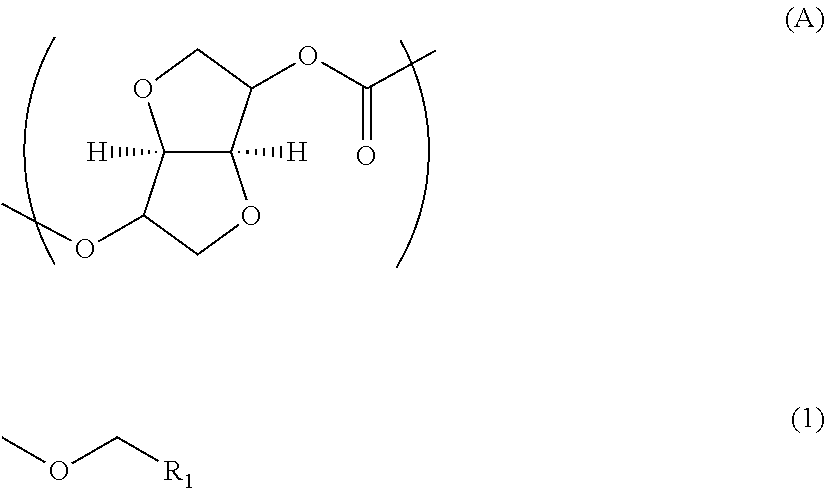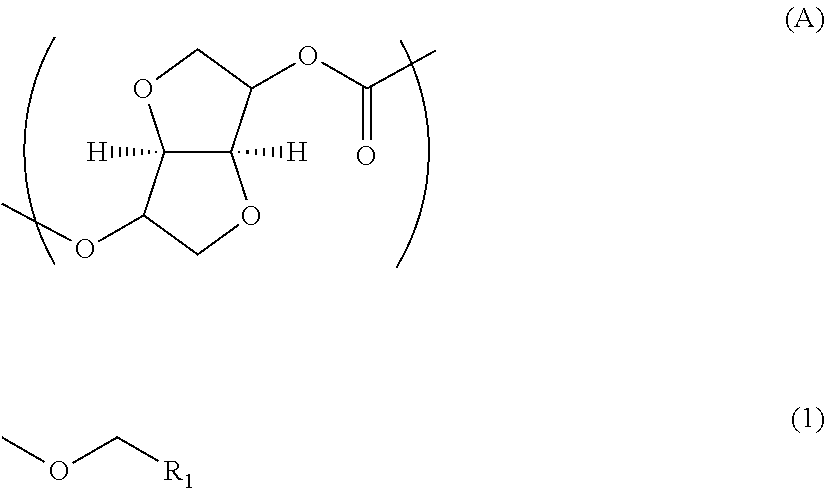Polycarbonate resin, and production method and film thereof
a technology of polycarbonate resin and production method, which is applied in the field of polycarbonate resin, can solve the problems of poor moldability, lack of high heat resistance, and polylactic acid, and achieve excellent hue and heat stability, excellent ultraviolet transmittance, and high heat resistance.
- Summary
- Abstract
- Description
- Claims
- Application Information
AI Technical Summary
Benefits of technology
Problems solved by technology
Method used
Image
Examples
example 1
[0173]432 parts of isosorbide (to be abbreviated as “ISS” hereinafter), 84 parts of 1,9-nonanediol (to be abbreviated as “ND” hereinafter), 9.5 parts of phenoxy ethanol, 750 parts of diphenyl carbonate (to be abbreviated as “DPC” hereinafter) and 0.0025 part of barium stearate as a catalyst were heated at 120° C. in a nitrogen atmosphere to be molten. Thereafter, the resulting solution was supplied into a reaction tank, the heat medium temperature of a capacitor was adjusted to 40° C., the internal temperature of the resin was adjusted to 170° C., and the decompression degree was adjusted to 13.4 kPa over 30 minutes.
(Step A)
[0174]Thereafter, the decompression degree was adjusted to 3.4 kPa over 20 minutes, and the resin temperature was adjusted to 170° C. and kept at that temperature for 10 minutes to carry out sampling. The obtained sample had a specific viscosity of 0.023.
(Step B)
[0175]After the decompression degree was further adjusted to 0.9 kPa over 30 minutes and the internal ...
example 2
[0178]The same operation and the same evaluations as in Example 1 were made except that the amount of phenoxy ethanol was changed to 14.2 parts. The results are shown in Table 1. The specific viscosity of the sample of the step A was 0.021, the specific viscosity of the sample of the step B was 0.082, the specific viscosity of the pellet obtained after the step C was 0.317, and the amount of the residual phenol was 121 ppm.
example 3
[0179]The same operation and the same evaluations as in Example 1 were made except that the amount of phenoxy ethanol was changed to 2.4 parts. The results are shown in Table 1. The specific viscosity of the sample of the step A was 0.025, the specific viscosity of the sample of the step B was 0.087, the specific viscosity of the pellet obtained after the step C was 0.367, and the amount of the residual phenol was 463 ppm.
PUM
| Property | Measurement | Unit |
|---|---|---|
| mol % | aaaaa | aaaaa |
| boiling point | aaaaa | aaaaa |
| transmittance | aaaaa | aaaaa |
Abstract
Description
Claims
Application Information
 Login to View More
Login to View More - R&D
- Intellectual Property
- Life Sciences
- Materials
- Tech Scout
- Unparalleled Data Quality
- Higher Quality Content
- 60% Fewer Hallucinations
Browse by: Latest US Patents, China's latest patents, Technical Efficacy Thesaurus, Application Domain, Technology Topic, Popular Technical Reports.
© 2025 PatSnap. All rights reserved.Legal|Privacy policy|Modern Slavery Act Transparency Statement|Sitemap|About US| Contact US: help@patsnap.com



